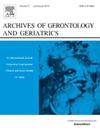Virtual obstacle-avoidance training using daily-life obstacles with physical feedback in older people: A cross-over trial
IF 3.5
3区 医学
Q2 GERIATRICS & GERONTOLOGY
引用次数: 0
Abstract
Failures in avoiding environmental hazards can lead to falls. We developed a virtual reality (VR) obstacle-avoidance training system that provides physical feedback upon foot contact with a virtual obstacle. This study aimed to assess whether physical feedback reduces obstacle collisions in older adults within a VR environment. Fifty-six participants (mean age 72.3 ± 5.4 (SD) years) wore an immersive VR head-mounted display and safety harness and walked on a split-belt treadmill in two 8-minute conditions performed in random order. They walked on a virtual suburban footpath, collecting virtual apples and avoiding slip-and-trip obstacles. In the perturbation condition (VR+P), foot-obstacle collisions were accompanied by immediate physical feedback via treadmill belt accelerations/decelerations. In the non-perturbation condition (VR-only), no physical feedback was provided. Obstacle collision rates and subjective acceptability were assessed. In the VR+P condition, participants had fewer obstacle collisions (0.63 versus 0.75), fewer trailing foot collisions (0.57 versus 0.68) and a greater margin of stability compared with the VR-only condition (p < 0.05). Participants reported significantly higher levels of anxiety and greater task difficulty for the VR+P condition (p < 0.05). Motion sickness was rarely reported, and enjoyment ratings were high, with no significant differences between the conditions. In summary, physical feedback reduced obstacle collisions and increased gait stability. The low levels of motion sickness and anxiety and high levels of enjoyment reported suggest that VR obstacle avoidance training is highly acceptable to older people. Future research is required to determine the generalisation of improved motor skills to real-world scenarios.
老年人使用日常生活障碍和身体反馈进行虚拟避障训练:交叉试验
未能避免环境危害可能导致跌倒。我们开发了一种虚拟现实(VR)避障训练系统,该系统可以在脚接触虚拟障碍物时提供物理反馈。这项研究旨在评估在VR环境中,身体反馈是否会减少老年人的障碍碰撞。56名参与者(平均年龄72.3±5.4 (SD)岁)佩戴沉浸式VR头戴式显示器和安全带,并在分带跑步机上随机进行两种8分钟的行走。他们走在一条虚拟的郊区小路上,收集虚拟的苹果,并避开滑倒和绊倒的障碍物。在摄动条件下(VR+P),脚-障碍物碰撞伴随着跑步机带加速/减速的即时物理反馈。在非扰动条件下(仅vr),不提供物理反馈。评估障碍物碰撞率和主观可接受性。在VR+P条件下,参与者的障碍碰撞次数更少(0.63比0.75),脚后跟碰撞次数更少(0.57比0.68),与仅VR条件相比,稳定性余地更大(P <;0.05)。在VR+P条件下,参与者报告了显著更高的焦虑水平和更大的任务难度(P <;0.05)。晕动病很少被报道,享受度很高,两种情况之间没有显著差异。总之,身体反馈减少了障碍物碰撞,增加了步态稳定性。据报道,低水平的晕动病和焦虑以及高水平的享受表明,VR避障训练对老年人来说是高度可接受的。未来的研究需要确定将改善的运动技能推广到现实场景中。
本文章由计算机程序翻译,如有差异,请以英文原文为准。
求助全文
约1分钟内获得全文
求助全文
来源期刊
CiteScore
7.30
自引率
5.00%
发文量
198
审稿时长
16 days
期刊介绍:
Archives of Gerontology and Geriatrics provides a medium for the publication of papers from the fields of experimental gerontology and clinical and social geriatrics. The principal aim of the journal is to facilitate the exchange of information between specialists in these three fields of gerontological research. Experimental papers dealing with the basic mechanisms of aging at molecular, cellular, tissue or organ levels will be published.
Clinical papers will be accepted if they provide sufficiently new information or are of fundamental importance for the knowledge of human aging. Purely descriptive clinical papers will be accepted only if the results permit further interpretation. Papers dealing with anti-aging pharmacological preparations in humans are welcome. Papers on the social aspects of geriatrics will be accepted if they are of general interest regarding the epidemiology of aging and the efficiency and working methods of the social organizations for the health care of the elderly.

 求助内容:
求助内容: 应助结果提醒方式:
应助结果提醒方式:


